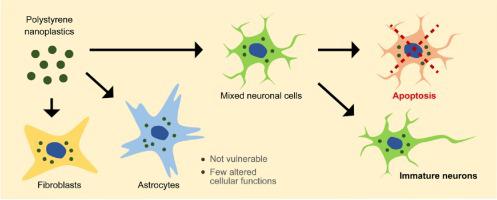NeuroToxicology ( IF 3.4 ) Pub Date : 2020-10-24 , DOI: 10.1016/j.neuro.2020.10.008 Byung-Kwon Jung 1 , Seung-Woo Han 1 , So-Hyun Park 1 , Jin-Sil Bae 1 , Jinhee Choi 2 , Kwon-Yul Ryu 1

|
Polystyrene (PS) and chemically modified compounds in the PS family have long been used in commercial and industrial fields. However, it is poorly understood whether nanoscale-PS microplastic or PS nanoplastic exposure leads to perturbations in fundamental cellular functions, such as proliferation, differentiation, and apoptosis. Herein, we cultured three types of primary cells, including mouse embryonic fibroblasts (MEFs), mixed neuronal cells isolated from embryonic cortex, and cortical astrocytes, and investigated the effects of their exposure to PS nanoplastics with a 100 nm diameter. Although PS nanoplastic exposure did not affect the viability of MEFs or astrocytes, it significantly reduced the viability of mixed neuronal cells. Consistent with the observed effect on cellular viability, levels of the apoptosis marker, cleaved caspase-3, were elevated exclusively in mixed neuronal cells. To investigate whether cells uptake PS nanoplastics into the cytoplasm, we exposed MEFs and neurons to fluorescent PS latex beads and monitored fluorescence over time. We found that PS nanoplastics were deposited and accumulated in the cytoplasm in a concentration-dependent manner. Although astrocytes were not apoptotic upon exposure to PS nanoplastics, they underwent reactive astrocytosis, with increased levels of lipocalin-2 and proinflammatory cytokines. Therefore, our findings suggested that the vulnerability of cells to the deposition and accumulation of PS nanoplastics in the cytoplasm was dependent on cell type. Furthermore, based on our data from primary cells originating from mouse brains, we suggest that reactive astrocytosis may contribute to the neuronal apoptosis seen in defective neurons with PS nanoplastics accumulated in the cell body.
中文翻译:

聚苯乙烯纳米塑料在源自小鼠大脑的原代细胞中的神经毒性潜力
聚苯乙烯 (PS) 和 PS 系列中的化学改性化合物长期以来一直用于商业和工业领域。然而,人们对纳米级 PS 微塑料或 PS 纳米塑料暴露是否会导致基本细胞功能(如增殖、分化和凋亡)的扰动知之甚少。在此,我们培养了三种类型的原代细胞,包括小鼠胚胎成纤维细胞 (MEF)、从胚胎皮层分离的混合神经元细胞和皮质星形胶质细胞,并研究了它们暴露于直径为 100 nm 的 PS 纳米塑料的影响。尽管 PS 纳米塑料暴露不影响 MEF 或星形胶质细胞的活力,但它显着降低了混合神经元细胞的活力。与观察到的对细胞活力的影响一致,细胞凋亡标志物的水平,裂解的 caspase-3,仅在混合神经元细胞中升高。为了研究细胞是否将 PS 纳米塑料吸收到细胞质中,我们将 MEF 和神经元暴露于荧光 PS 乳胶珠并随时间监测荧光。我们发现 PS 纳米塑料以浓度依赖性方式沉积和积累在细胞质中。尽管星形胶质细胞在暴露于 PS 纳米塑料后不会凋亡,但它们会发生反应性星形细胞增多症,脂质运载蛋白 2 和促炎细胞因子水平升高。因此,我们的研究结果表明,细胞对 PS 纳米塑料在细胞质中沉积和积累的脆弱性取决于细胞类型。此外,根据我们来自小鼠大脑的原代细胞的数据,











































 京公网安备 11010802027423号
京公网安备 11010802027423号